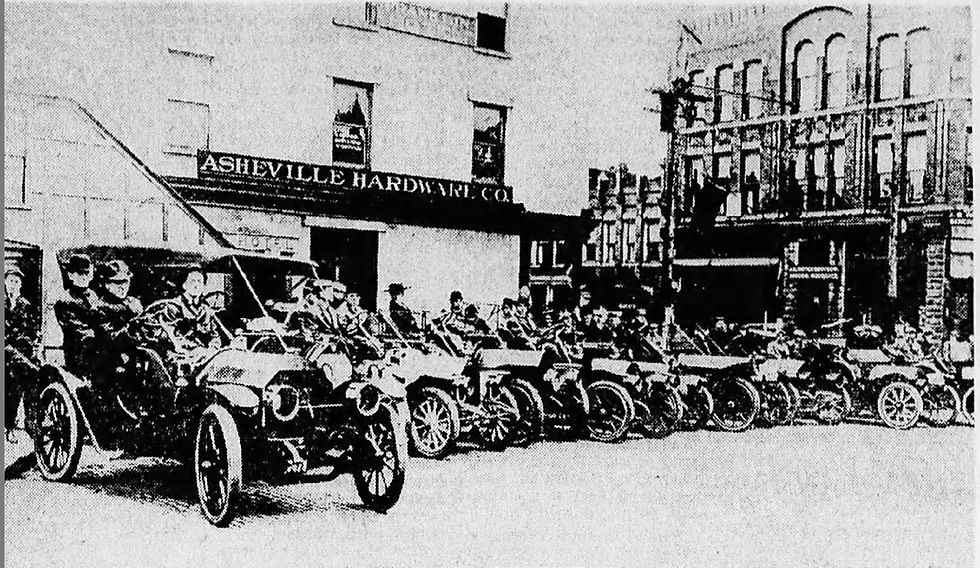Fairy Tale Journey to the Douglas Ellington House
- Heath Towson
- Oct 8, 2023
- 4 min read

Douglas Ellington - Source Douglas Dobell Ellington - Douglas Ellington - Wikipedia
If you have been in Asheville long enough, at some point in your travels the name Douglas Ellington will come up. Ellington is known for the design of many of Asheville's Art Deco treasures including First Baptist Church, The Asheville City Hall Building, Asheville High School, The S&W Building and the Merrimon Avenue Fire Station. Ellington came to Asheville in the 1920s to design First Baptist Church as his first architectural commission.

Ellington designed Asheville City Hall - Southern Appalachian Digital Collection, UNCA and WCU
Ellington also did many other residential projects in Asheville which included the C.C. Peek house at 128 Windsor Road, the Dalton House at 103 Wembley Road, Kells Castle at 24 Kimberly Ave., The Starnes House at 2 Clarendon Road, the Stribling House at 500 Elk Mountain Scenic Highway, The Cazel House at 131 Shelburne Road in Candler - just to name a few. He is also known for the design of the office at Lewis Memorial Cemetery in Beaverdam, as well as the Chimney Rock Park Gateway - if you would like to make a list of Ellington places to visit!
Douglas Ellington was born in Clayton, North Carolina on June 26th, 1886 to Jesse and Sally Ellington. He was educated at Randolph-Macon College, Drexel Institute, The University of Pennsylvania and the Ecole des Beaux Arts in Paris. While studying in Paris, he became the first Southerner to win the coveted Prix de Paris and the only American at that time to be awarded the Prix Rougevin. The Rougevin is a traditional festival of architectural students of the Ecole des Beaux-Arts de Paris, which took place from 1891 to 1966. Along with the Bal des Quat'a'Arts and the Gala de la Grande Masse, it is one of the three most important traditional celebrations for Fine Arts Students of the Ecole in Paris. He concluded his studies at the Ecole just prior to the outbreak of the first World War. During World War I, Mr. Ellington supervised the development of camouflage for ships that helped them blend in with waves called "dazzle" camouflage.

Dazzle Camouflage ship - Source: When the British Wanted to Camouflage Their Warships, They Made Them Dazzle | History| Smithsonian Magazine
After World War I, Ellington secured several consecutive teaching positions which included Drexel, Columbia University and finally Carnegie Institute of Technology in Pittsburgh, Pennsylvania. It was in Pittsburgh, that he began his own architectural practice in 1920 with his younger brother Kenneth Ellington serving as his office manager, who was a full-time lawyer.
Not only was Ellington a highly skilled architect, he was also a fine watercolor painter and was known for painting landscapes in oil. He went on to author a collection of watercolor paintings of the Virgin Islands shown by the American Government in the Intercolonial Exhibition in Paris. Many of his paintings are in the collection of the Asheville Art Museum today. His architecture practice extended throughout the entire Eastern Seaboard and ranged from the architectural design and approaches of the famous system of steel bridges at Pittsburgh, Pennsylvania to the St. Andrews Presbyterian Church in Charleston.
When it came time for a man of his background in design to construct his own residence in Chunns Cove, he decided to take a more rustic, old-world approach. Douglas would start to construct his own residence in Chunns Cove in 1926, out of surplus building materials from other architectural commissions in Asheville. Ellington had relocated his practice to Asheville in 1926 when he was awarded the commission for First Baptist Church. Ellington, who had strong artistic talents, was also very hands on and sensible in his design. He was said to often join the workmen on site to demonstrate how he wanted to place a stone or other element in a building. His house was said to be made of stone and brick with pieces left from city hall, Asheville High School and other projects. He did not allow any machinery on the property during the construction of the house and built it by hand.

Douglas Ellington Home, Chunns Cove - Photo by Camilla Calnan, Asheville NC
After the Great Depression exacted its toll on Asheville, Ellington was forced to move back to Washington, D.C. to secure work. He would continue to come and visit Asheville and his family has held on to his home in Chunns Cove all this time. Douglas Ellington died August 28, 1960 at the age of 74.
Ellington's Chunns Cove home is now available on a limited basis for weddings and special events. As part of these offerings, Mountaineer Motor Tours was invited out to the Ellington house in Chunns Cove for a styled photo shoot with other wedding vendors. We were chosen as the "get away" car for a period correct wedding! Below are some of the stunning images that were captured by Asheville photographer, Camilla Calnan:
Photo Gallery from Exploring the Douglas Ellington House, Chunns Cove
For more information on the house or booking an event, visit:
Sources of Historical Information:
Asheville Citizen-Times. (August 28, 1960). Douglas D. Ellington Obituary. Newspapers.com. Retrieved October 7, 2023, from https://www.newspapers.com/article/asheville-citizen-times-douglas-d-ellin/31199491/
.jpg)



































Comments